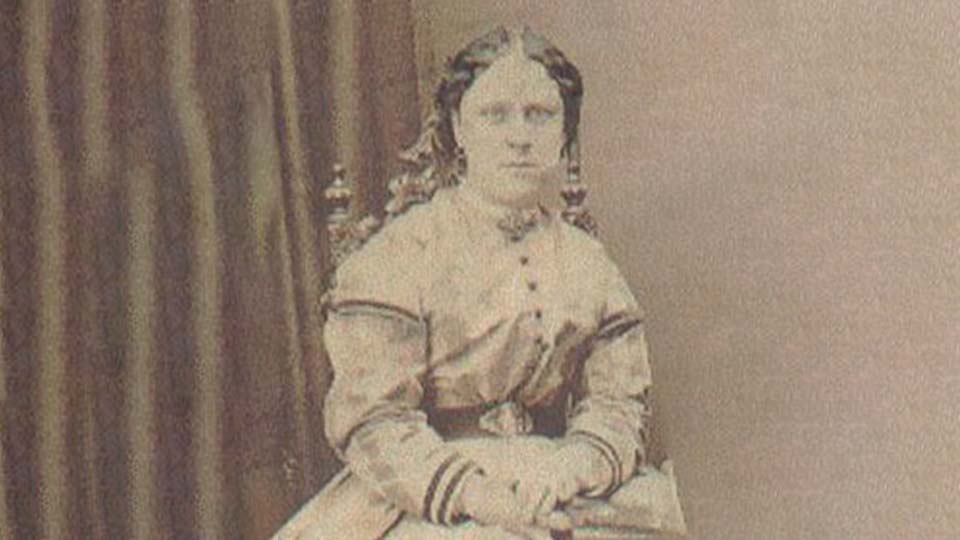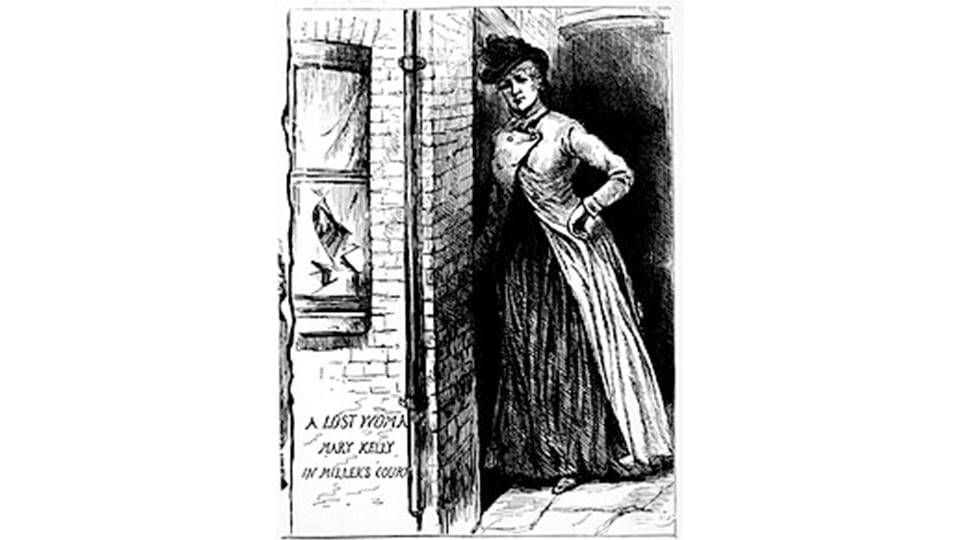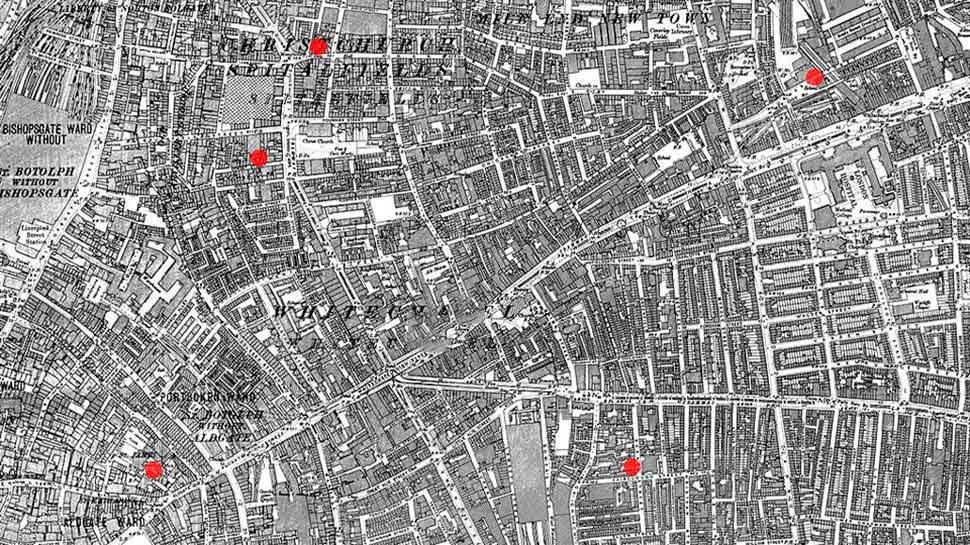Five women, all prostitutes and murdered at night or in the early morning, were found dead between August and November 1888 in England.
The “canonical five” as they were popularly called at the time, were victims of the famous — and never identified — serial killer: “Jack the Ripper“.
Background
All the murders took place in the largely impoverished areas in and around the Whitechapel district of London in 1888. The city, at that time, had one of the worst possible scenarios. With a post-industrial society, many immigrants and war refugees, extremely poor and with a low supply of jobs, the East End was not able to offer much to anyone who settled there.
Forgotten by society, marginalized and virtually lawless, the area was extremely attractive to criminals. Robberies, murders, and sexual crimes were on the rise there.
The presence of a busy port brought many sailors to the city, so bars and brothels were the businesses that could bring in a profit. Hunger and the need for employment drove some 1200 women into prostitution, they offered their services in dozens of brothels around Whitechapel.
Murders
Five victims have been attributed to Jack, but other murders similar to his modus operandi took place around the same time. It is suspected that he may have been the perpetrator of them, although evidence is lacking.
Mary Ann Nichols, first victim
Jack the Ripper’s first victim would have been Mary Ann Nichols. The woman, although described as having a “youthful appearance”, was 43 years old, her hair was brown and gray, and her height was 5’1” (1,57m)
His body was found at 3:40 a.m. on August 31, 1888, near a stable. His throat had two cuts, the lower part of his abdomen was open from a deep knife cut, and the rest of his belly had many more superficial stab marks.
Annie Chapman
Eight days after the death of the first victim, on a Saturday morning the body of 47-year-old Annie Chapman was found in the backyard of a house. Annie also had deep cuts in her throat, but this time besides opening the victim’s abdomen more deeply, the killer removed her uterus.

In a statement to the police, a witness claimed to have seen Chapman in the company of a poorly dressed man with brown hair, but who did not look suspicious to him.
Elizabeth Stride and Catherine Eddowes
The third and fourth victims were killed on the same day, in the early morning hours of September 30, 1888. With a difference of approximately four hours between the murders.
Elizabeth Stride, 45, or Long Liz, as she was called by her friends, was found dead on a sidewalk at 1 a.m. There was only one deep cut on her throat, more precise than on the first victims, and it hit her left carotid artery, causing her to die from bleeding.
There were no other injuries, this raised questions about who would be the perpetrator, or whether the killer would have been stopped during the attack. The body was found at night, on a busy street, and it is quite possible that the perpetrator fled for fear of being identified.
Witnesses differed in their statements. One said she saw Stride in the company of a man with blond hair, another said she saw her with a man with brown hair. They also differed on the clothing, sometimes the man was poorly dressed and sometimes he was wearing expensive clothes.
On the other hand, Catherine Eddowes, 46, was found dead in Mitre Square in London. She had her face mutilated and there were also cuts on her throat and deep incisions in her abdomen.
In Catherine’s case, the killer removed some of her organs and positioned them next to her head, he also took her left kidney with him. Apparently the perpetrator had more time to act in this case.
She was last seen by Joseph Lawende, a salesman on his way home with his friends. He saw Eddowes talking to a man at the entrance of Mitre Square. But his statement brought nothing relevant to the investigation.
An important fact about this particular murder is that in the hours following the discovery of the bodies, the police found a fragment of the victim’s clothing under a porch on a street near Mitre Square. With traces of blood on it, the garment was probably used by the killer to clean himself after the murder.
Mary Jane Kelly
On November 9, 1888, the murder of Mary Jane Kelly closes the series of five crimes allegedly committed by Jack the Ripper.
Mary’s body was found on her bed, in the guesthouse she was renting, at 10:45 in the morning. Her throat was cut and violently shredded down to the spine, and almost all of her internal organs were removed. The heart was not found at the scene, and it is believed that the killer took it with him.

One of her breasts was found next to her foot, and part of her thighs were missing. The killer also scattered mutilated parts of her body all over the guesthouse room, and Mary Jane’s blood was running all over the floor.
She was the youngest victim, she was 25 years old at the time and living in extreme poverty.

Criminal profiling
All the crimes were committed during the night or early morning hours, the five victims worked at least eventually as prostitutes and were in financial difficulties.
As the crimes were committed, the killer became more and more violent. Some investigators suggested that the perpetrator possibly had anatomical and even medical knowledge, due to the high quality of his cuts and incisions.
Others ignore these clues and claim that Jack the Ripper was a lonely man and with mental problems who was looking for prostitutes to hook up with and then murdering them.
Kelly was considered the last victim, because it is believed that after her the killer fled for fear of being caught, since the case has attracted a lot of media attention, or was arrested for some other crime.
Other murders of that time were quickly linked to Jack, but dismissed later, either because of the location of the crime or the modus operandi that differed.
After all, who is Jack the Ripper?
There are many theories about the true identity and profession of Jack the Ripper, but authorities do not agree with them, and there are more than a hundred suspects even today, including the American H. H. Holmes.
But the fact is, there is no concrete proof of who Jack was. There are even some documentaries that claim to have identified the serial killer through genetic evidence, but none of them have proven this in a consistent way.










